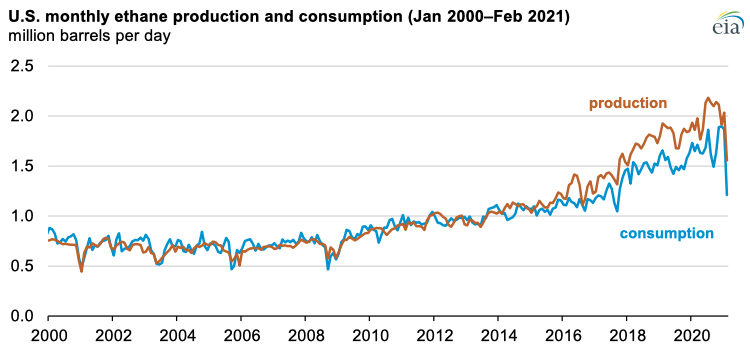In February 2021, extremely cold winter weather in the Gulf Coast region resulted in outages at most petrochemical plants in the area, causing the largest monthly decline in demand for ethane feedstock on record. Ethane consumption (we use product supplied as a proxy for consumption) in February dropped 654,000 barrels per day (b/d) from January 2021 to a total of 1.21 million b/d. This level was the lowest level of ethane consumption since October 2017, when the U.S. Gulf Coast was recovering from the impacts of Hurricane Harvey.

The cold weather in Texas in February 2021 caused the largest monthly decline in natural gas production on record, resulting in elevated natural gas prices throughout the country. Because of high prices and demand for home heating, natural gas deliveries to residential customers took priority, and deliveries to industrial users halted entirely, including to petrochemical crackers and other customers who use natural gas for process heat and for onsite electricity and steam production.
These curtailments led to unplanned shutdowns at all petrochemical crackers and associated facilities in Texas, as well as at some plants in Louisiana. The slow restarts of petrochemical plants, some of which suffered damage as a result of the sudden shutdowns, resulted in lower demand for ethane through the remainder of February and, for many plants, throughout March and into April. The reduced ability of petrochemical crackers to convert ethane into ethylene, in turn, affected downstream petrochemical units. Petrochemical plants convert ethylene into the plastics and resins used to manufacture consumer products, such as plastic bottles, carpet, or polyester clothing.
Although a variety of weather events can occasionally result in reduced Gulf Coast petrochemical activity, major hurricanes are usually the primary reason. The cold-weather event in mid-February was unusual, not only because of the season but also because of the magnitude of the impact, which far exceeded the drop in consumption caused by previous weather events.
When Hurricane Laura made landfall in Louisiana at the end of August 2020, the cleanup and lack of power around Lake Charles, Louisiana, caused ethane consumption to drop by 126,000 b/d in September 2020 from the month before. Similarly, when Hurricane Harvey hit the Gulf Coast region in August and September 2017, ethane consumption fell by 84,000 b/d. These two hurricane-related decreases were less than the 654,000 b/d month-over-month decrease in ethane consumption that resulted from February’s winter storm.
Principal contributors: Joshua Eiermann, Warren Wilczewski

Follow us on social media: